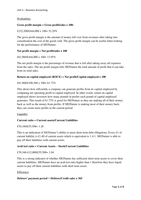Unit 5 – Business Accounting
Profitability
Gross profit margin = Gross profit/sales x 100:
£232,200/£444,000 x 100= 52.29%
The gross profit margin is the amount of money left over from revenues after taking into
consideration the cost of the goods sold. The gross profit margin can be useful when looking
for the performance of SIGNature.
Net profit margin = Net profit/sales x 100
£61,960/£444,000 x 100= 13.95%
The net profit margin is the percentage of revenue that is left after taking away all expenses
from the sales. The net profit margin tells SIGNature the total amount of profit that it can take
from its total sales.
Return on capital employed (ROCE) = Net profit/Capital employed x 100
£61,960/£100,360 x 100= 61.73%
This shows how efficiently a company can generate profits from its capital employed by
comparing net operating profit to capital employed. In other words, return on capital
employed shows investors how many pounds in profits each pound of capital employed
generates. This result of 61.73% is good for SIGNature as they are making all of their money
back as well as the money from profits. If SIGNature is making most of their money back,
they can create more profits in the current period
Liquidity
Current ratio = Current assets/Current Liabilities
£70,160/£55,500= 1.26
This is an indication of SIGNature’s ability to meet short-term debt obligations. Every £1 of
current liability is £1.40 of current assets which is equivalent to 1.4:1. SIGNature is able to
pay off their liabilities with current assets.
Acid test ratio = Current Assets – Stock/Current Liabilities
£70,160-£12,000/£55,500= 1.04
This is a strong indicator of whether SIGNature has sufficient short-term assets to cover their
current liabilities. SIGNature have an acid-test ratio higher than 1 therefore they have liquid
assets to pay off their current liabilities with short term assets.
Efficiency
Debtors’ payment period = Debtors/Credit sales x 365
Page 1 of 4





